![]()
Written By Liz Eggleston
Course Report strives to create the most trust-worthy content about coding bootcamps. Read more about Course Report’s Editorial Policy and How We Make Money.
Overview
Course Report is pleased to present our fifth Market Sizing Report, another in-depth, empirical study that takes stock of the coding bootcamp industry. Course Report polled every full-time, in-person US/Canadian bootcamp with courses in web and mobile development, gathering statistics on 2017 graduates and projected 2018 graduation rates. Our response rate was once again impressive: 93% of schools responded.
This year marks the 6th anniversary for the coding bootcamp industry, and the number of coding bootcamp graduates has grown since the first bootcamps launched in 2012. Coding bootcamps are a $240 million industry and will graduate ~20,000 developers in 2018.
Note: in previous years, we’ve included only in-person, full-time bootcamps. This year, our survey also includes full-time, instructor-led, online coding bootcamps (see Inclusion Criteria for more info).

Key Findings
Coding bootcamps will graduate over 20,000 students in 2018 and are expanding into Corporate Training & Online Education in 2018. Course Report found:
- In 2018, the coding bootcamp market will grow by 20%, to an estimated 20,316 graduates in 2018, up from 16,867 in 2017. 1
- Trend Alert: 24 bootcamps work with partners on corporate training; this year, these 24 bootcamps expect to teach an additional 16,593 students via 634 corporate training partners (growth of 111% since 2017).
- Online coding bootcamps are new to this report in 2018; 1,846 (of the total 20,316 students) will graduate from full-time, online coding bootcamps this year.
- As a point of comparison, we estimate that there were 93,427 undergraduate computer science graduates from accredited US universities in 2017. 2
- In 2018, there are 95 in-person bootcamp providers and 13 online bootcamp providers. As of June 1, there are coding bootcamps in 86 US cities and 44 states.
- Average tuition price of qualifying in-person courses is $11,906, with an average program length of 14.4 weeks. Online bootcamps are slightly less expensive ($11,118) and slightly longer (15.4 weeks).
- We estimate that tuition revenue from qualifying in-person schools will be $219,906,323 in 2018, excluding scholarships and $20,523,828 from online schools in 2018. Trend Alert: 16 bootcamps offer Deferred Tuition or Income Sharing Agreements in 2018.
- This year, Full Stack JavaScript continues to be the most common teaching language, used in 51% of Web Development bootcamps.
| 2017 Coding Bootcamp Market Size Study |
| 2017 Graduate Outcomes + Demographics Study |
| 2016 Coding Bootcamp Market Sizing Study |
1 Note: the 2017 figure does not include online coding bootcamp graduates.
2Weestimated undergraduate CS graduates by using the 2017 Taulbee Study, published by the CRA (https://cra.org/wp-content/uploads/2018/05/2017-Taulbee-Survey-Report.pdf). The Taulbee Study is a survey of PhD-granting departments, released annually in May. The National Center for Science and Engineering Statistics compiles statistics on undergraduate degrees, but hasn’t published statistics since 2011. We assumed that Taulbee captured 26% of the total undergraduate degrees, based on the most recent comparison published at http://cra.org/crn/2012/11/counting_computing_cra_taulbee_survey_and_nsf_statistics/.
Results
Teaching Languages
*note: these findings apply to in-person courses only
Web Development coding bootcamps have historically been taught using Ruby on Rails, Full-Stack JavaScript, .NET/C#, Java, Python, or PHP. In 2018, Full-Stack JavaScript has maintained its position as the primary teaching language. 51% of courses reported Full-Stack JavaScript as the primary programming language (Chart 1a). Not only are schools new to the market choosing JavaScript, but established bootcamps are also migrating their curricula to emphasize JavaScript. Although this study does not report on specific JavaScript technologies taught, one trend to note is the transition to React (shifting curricula from “MEAN Stack” to “MERN Stack.”)
Chart 1a: Top Full-Stack Web Development Teaching Languages by Courses
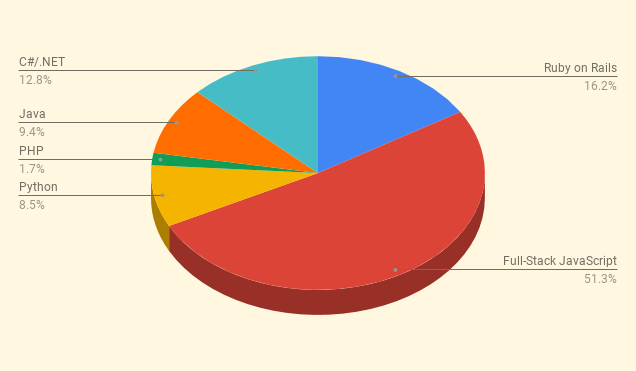
Mobile Development coding bootcamps have historically been taught using Java (Android), Objective-C (iOS), or Swift (iOS). In 2018, 57% of Mobile Development bootcamps teach iOS with Swift (Chart 1b), marking a shift from Objective-C to Swift.
Chart 1b: Top Mobile Development Teaching Languages by Courses
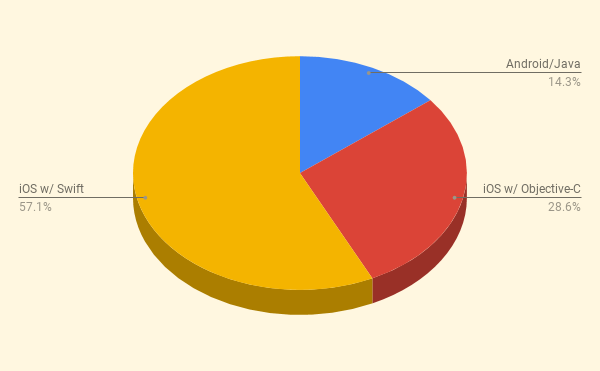
This year’s market sizing report includes bootcamps that provide coding-specific curriculum with a focus on Full-Stack Web Development, Mobile Development, or Front-End Web Development. Of these three career tracks, Chart 1c shows the continued popularity of Full-Stack Web Development – 91% of coding bootcamp grads learn Full-Stack Web Development (Chart 1c).
Chart 1c: Top Career Tracks by Graduates
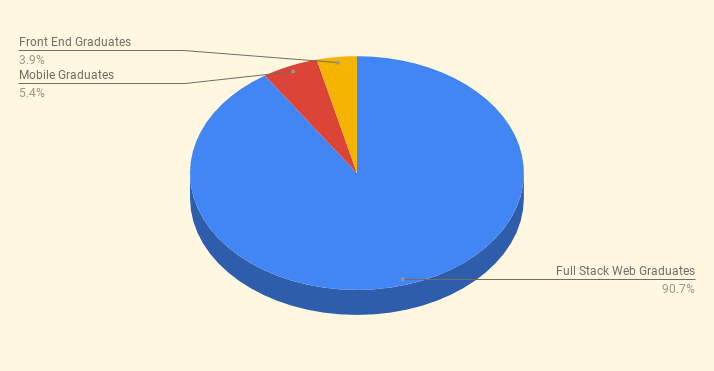
| 2017 Coding Bootcamp Market Size Study |
| 2017 Graduate Outcomes + Demographics Study |
| 2016 Coding Bootcamp Market Sizing Study |
Location (US)

As of June 1, 2018, there are coding bootcamp courses in 86 US cities and 44 states, and 13 online.
Location data is from a sample of 274 courses from all 95 qualifying schools. Table 5, Table 6, Table 7, and Table 8 refer to number of courses in each location.
| City | # bootcamp courses |
|---|---|
| New York City | 22 |
| San Francisco | 13 |
| Seattle | 13 |
| Dallas | 11 |
| Chicago | 9 |
| Los Angeles | 8 |
| Denver | 8 |
| Boston | 8 |
| Portland | 7 |
| Atlanta | 7 |
| State | # bootcamp courses |
|---|---|
| California | 42 |
| New York | 29 |
| Texas | 20 |
| Washington | 13 |
| Ohio | 10 |
| North Carolina | 10 |
| Illinois | 9 |
| Georgia | 9 |
| Colorado | 9 |
Location (Canada)
The 2018 Market Sizing Study again includes Canadian bootcamps. These 6 Canadian bootcamps graduated 943 students in 2017, will graduate an estimated 1,140 in 2018, and will generate $13,533,595 in revenue in 2018. The most popular teaching language in Canadian bootcamps is divided evenly between Ruby on Rails and MEAN Stack.
As of June 1, 2018, there are coding bootcamp courses in 5 Canadian cities and 4 provinces.
| City | # bootcamp courses |
|---|---|
| Vancouver | 7 |
| Toronto | 6 |
| Montreal | 2 |
| Victoria | 1 |
| Calgary | 1 |
| State | # bootcamp courses |
|---|---|
| British Columbia | 8 |
| Ontario | 6 |
| Quebec | 2 |
| Alberta | 1 |
| 2017 Coding Bootcamp Market Size Study |
| 2017 Graduate Outcomes + Demographics Study |
| 2016 Coding Bootcamp Market Sizing Study |
Comparison to 2017 Study
Accuracy
Our 2017 Market Sizing Study projected the 2017 market size of in-person coding bootcamp graduates to be 22,949 graduates. Our 2018 study finds that the actual market size in 2017 for in-person graduates was 16,164 graduates. Thus, coding bootcamps overestimated their 2017 growth by 42%. This underestimation may be in part because 24 coding bootcamps shifted some resources towards corporate training (see Corporate Training findings).
| 2017 Coding Bootcamp Market Size Study |
| 2017 Graduate Outcomes + Demographics Study |
| 2016 Coding Bootcamp Market Sizing Study |
Tuition
Tuition ranges from free to $24,000 for an in-person course, with an average tuition of $11,906. Courses range from 4 to 104 weeks with an average of 14.3 weeks, but most courses are in the 12 week range. Our study focuses on full-time programs, where students typically commit at least 40 hours per week, between classroom and programming time. The average Online bootcamp costs $11,118 and lasts 15.4 weeks.
| Tuition | % |
|---|---|
| Less than $5,000 | 1% |
| $5000 - $9,999 | 27% |
| $10,000 - $14,999 | 55% |
| Greater than $15,000 | 13% |
| Deferred Tuition | 4% |
| Income Sharing Agreement | 4% |
| Tuition Info Not Available | 2% |
Based on our estimate of 18,470 in-person graduates in 2018, we estimate tuition revenue for in-person schools at $219,906,323 in 2018, excluding rebates and scholarships. Some schools also collect placement fees from employers for students accepting full-time jobs after graduation. Many schools offer job-placement rebates, ranging from a few thousand dollars to the entire tuition. Typically, rebates are offered to students who receive a qualifying job through the school’s job placement program or in the form of a money-back guarantee for students not placed in jobs.
Based on our estimate of 1,846 online graduates, we estimate revenue for online bootcamps at $20,523,828, excluding rebates and scholarships.
Trend: Alternative Tuition Models
In 2018, 16 schools offer alternative tuition options like deferred tuition, income sharing agreements, or employer-sponsorship.
- 5 schools offer deferred tuition (students pay back a fixed tuition amount in installments): App Academy, Flatiron School Access Labs, Hackbright Academy, The Grace Hopper Program, and Nashville Software School.
- 12 schools offer income sharing agreements (students pay the school a percentage of their salary for a period of time): C4Q Access Code, DigitalCrafts, Holberton School, Kenzie Academy, Lambda School, Launch School, New York Code + Design Academy, Make School, Springboard, Thinkful, Turing School, and V School.
- 3 schools offer an employer-sponsorship model: Ada Developers Academy, Revature, and Zip Code Wilmington.
| 2017 Coding Bootcamp Market Size Study |
| 2017 Graduate Outcomes + Demographics Study |
| 2016 Coding Bootcamp Market Sizing Study |
Market Size: 2018 Graduates
After surveying school representatives from the 108 qualifying coding bootcamps, Course Report estimates that coding bootcamps will educate 36,909 graduates in 2018 – this includes in-person coding bootcamps, online coding bootcamps, and corporate training.
| Self-Reported Graduates | |
|---|---|
| 2018 in-person graduates (projected) | 18,470 |
| 2018 online bootcamp graduates | 1,846 |
| 2018 corporate training graduates | 16,593 |
| Total 2018 graduates | 36,909 |
Market Size: In- Person
After surveying school representatives from the 95 qualifying US/Canada-based in-person coding bootcamps, Course Report estimates a 14% growth rate for the in-person coding bootcamp market in 2018.
| Self-Reported Graduates | |
|---|---|
| 2013 graduates (actual) | 2,178 |
| 2014 graduates (actual) | 6,740 |
| 2015 graduates (actual) | 10,333 |
| 2016 graduates (actual) | 15,077 |
| 2017 graduates (actual) | 16,190 |
| 2018 graduate (projected) | 18,470 |
| Estimated growth rate (2017-2018) | 14% |
| Industry growth rate since 2013 | 748% |
Market Size: Online
| Self-Reported Graduates | |
|---|---|
| 2017 graduates (actual) | 677 |
| 2018 graduates (projected) | 1,846 |
| Estimated growth rate (2017-2018) | 173% |
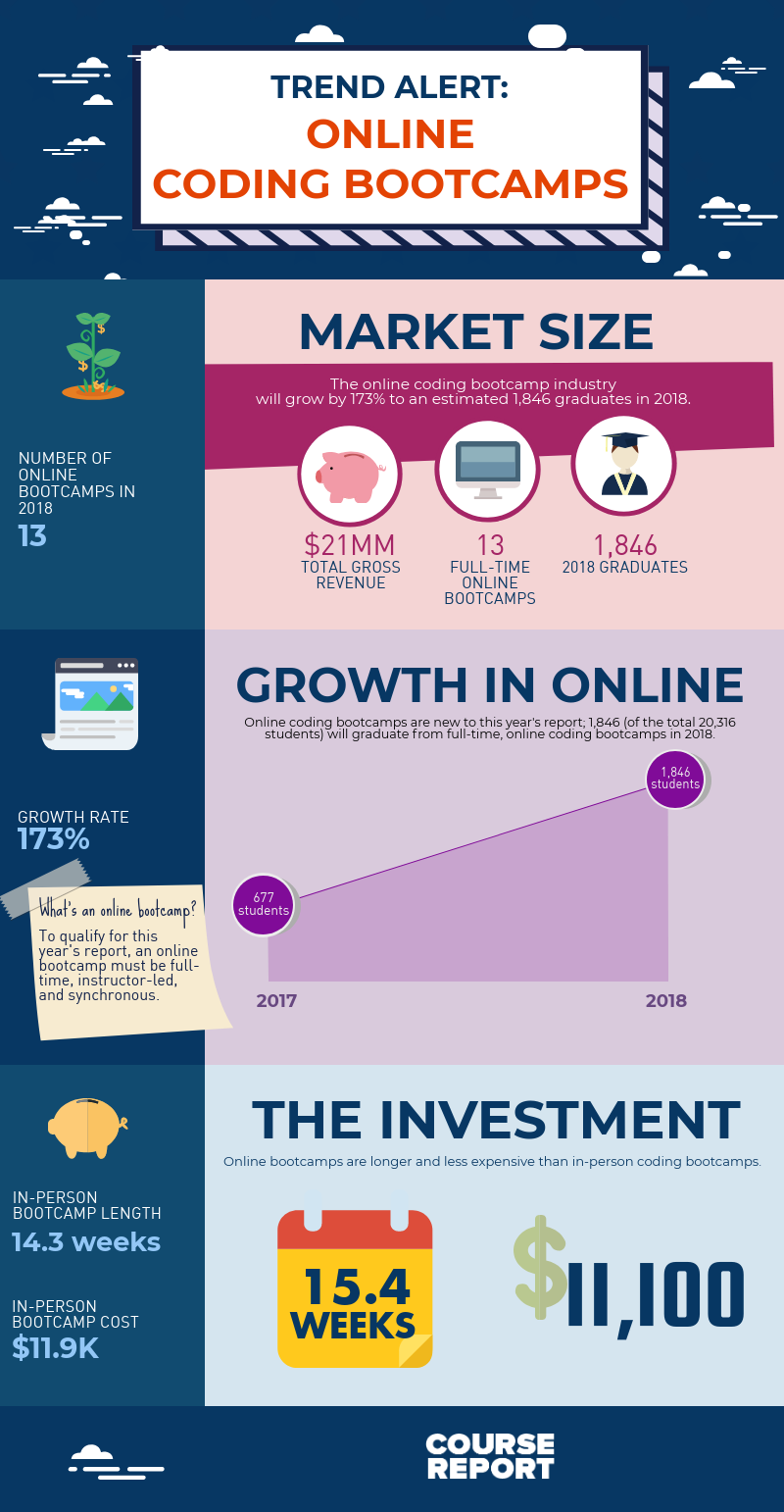
New Schools
Among the respondents, 6 schools reported “zero” graduates in 2017 (ie. the schools were new to the industry in 2017). That group expects to graduate 274 students in 2018. Among the 86 participating schools we surveyed, 63 schools expect to grow in 2018.
Closed Schools
There are 95 coding bootcamps offering full-time in-person programming courses in the US/Canada in 2018. This accounts for 7 schools that have closed or were consolidated/acquired and 5 schools that no longer qualify for inclusion in this report (see more in Participating Schools).
| 2017 Coding Bootcamp Market Size Study |
| 2017 Graduate Outcomes + Demographics Study |
| 2016 Coding Bootcamp Market Sizing Study |
Market Size
While the size of the coding bootcamp market has leveled out, we find that coding bootcamps are putting more resources into training new developers through Corporate Training partnerships. In 2018, 24 bootcamps report that they have corporate training partnerships. Tables 9 & 10 show the growth of this category.
| # graduates | |
|---|---|
| 2017 graduates | 7,858 |
| 2018 graduates | 16,593 |
| Growth Rate | 111% |
| # partners | |
|---|---|
| 2017 partners | 440 |
| 2018 partners | 634 |
| Growth Rate | 44% |
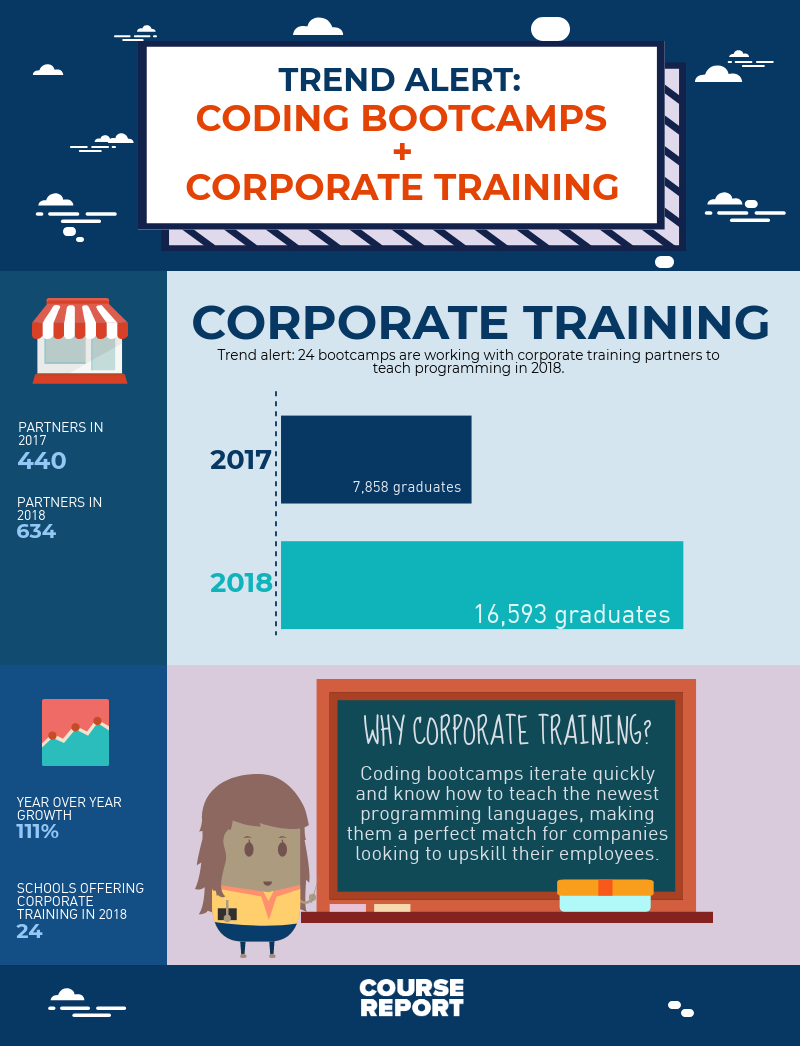
| 2017 Coding Bootcamp Market Size Study |
| 2017 Graduate Outcomes + Demographics Study |
| 2016 Coding Bootcamp Market Sizing Study |
Participating Schools
In-Person:
Online:
| BrainStation | Big Sky Code Academy | Covalence | |
| Coding Dojo | Fullstack Academy | General Assembly | |
| Hack Reactor | Lambda School | The Software Guild | |
| Thinkful | We Can Code IT | V School | |
Missing from 2018 Study:
- Only one school refused to participate in the study: Sabio.
- 6 schools were non-responsive: Make School, C4Q Access Code*, Acclaim Education*, Blue Ocean Coding, Arkansas Coding Academy, Disruption Institute. The only non-responsive online bootcamp was Microverse.
- 2 of those schools – C4Q Access Code and Acclaim Education, participated in our 2017 report but failed to respond in 2018. The industry growth rate was applied to reported 2017 graduates. To establish an “Industry Growth Rate,” we calculated the growth rate from 2017-2018 of actual reported graduates for a growth rate of 36%. We only included schools who fully participated in both 2017 and 2018.
12 bootcamps are not included in the 2018 study which were included in 2017, for a variety of reasons:
- Schools that participated in 2017 but no longer qualify for this report (ie. teach children only, changed to part-time only, etc): Startup Institute, SD Code Bootcamp, LaunchCode, Gainesville Dev Academy, and Noble Desktop.
- Code Tahoe, Cultivating Coders, Dev Bootcamp3, The Iron Yard4, GTT Academy, Omaha Code School, and Upscale Academy are closed.
| 2017 Coding Bootcamp Market Size Study |
| 2017 Graduate Outcomes + Demographics Study |
| 2016 Coding Bootcamp Market Sizing Study |
3 Because Dev Bootcamp closed at the end of 2017, we included 2017 graduates. Dev Bootcamp is not included in 2018 numbers.
4Because The Iron Yard closed at the end of 2017, we included 2017 graduates. The Iron Yard is not included in 2018 numbers.
Methodology
In our fifth annual Course Report Survey, we surveyed a total of 108 coding schools, commonly referred to as “bootcamps” or “accelerated learning programs.” Of the schools surveyed, which had to meet a set of criteria described below, 100 completed the survey, for a response rate of 93% percent. The surveys were sent to school representatives and graduation figures are self-reported by the respondents.
Criteria – In-Person. To qualify for inclusion in the survey, a school must (a) offer full-time, in-person instruction of 40 or more hours of classroom time per week, (b) not be administered by an accredited college or university, (c) provide coding-specific curriculum with a focus on Full-Stack Web Development, Mobile Development, or Front-End Web Development (a separate report will be released for schools specializing in product development, data science, design, marketing, or security), and (d) have campuses in the United States or Canada. Many schools offer courses at multiple campuses across a wide range of curriculums. Respondents were asked to only report on courses meeting the above criteria (full-time, in-person, non-accredited, programming-specific, United States/Canada).
Criteria – Online. This year, we surveyed online bootcamps for the first time. To qualify for inclusion in the survey, a school must (a) offer full-time, synchronous, online instruction of 40 or more hours of classroom time per week, (b) not be administered by an accredited college or university, (c) provide coding-specific curriculum with a focus on Full-Stack Web Development, Mobile Development, or Front-End Web Development and (d) be instructor-led.
2018 Forecast. All participants reported the number of students who graduated in 2017. All participants also provided estimates of their expected, 2018 graduate total.
Course Analysis. In addition to survey responses, we utilized the Course Report database of individual, in-person course sections to identify a sample of 274 courses (used in Table 4 and Chart 1) from all 95 qualifying in-person schools. To qualify for our sample, the course needed to meet all of the above criteria and have a start date in 2018.
About Course Report. Course Report, founded in 2013 by Liz Eggleston and Adam Lovallo, operates https://www.coursereport.com/, which helps potential students find and research coding bootcamp programs. Course Report offers a directory of schools, course schedules, reviews and interviews with teachers, founders, students, and alumni.
